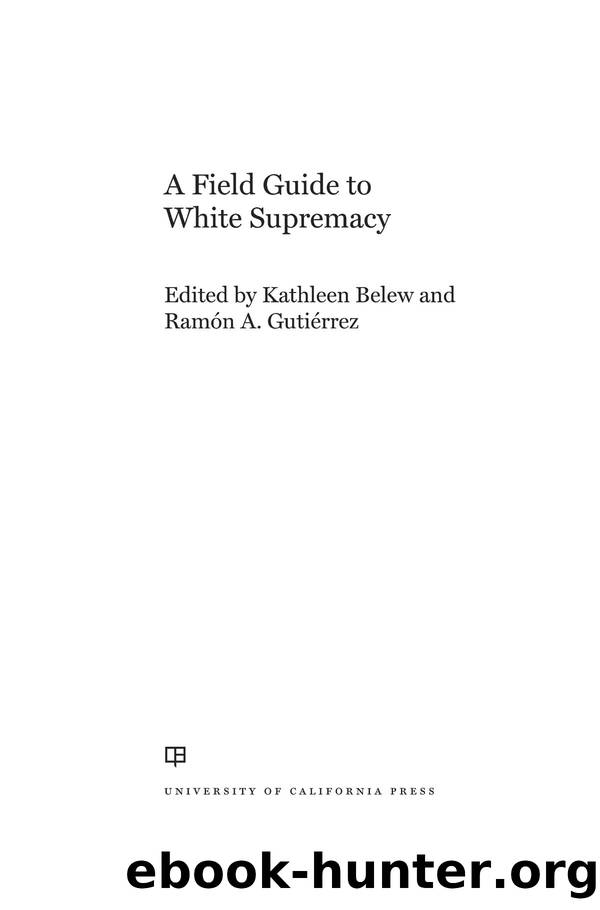A Field Guide to White Supremacy by Kathleen Belew

Author:Kathleen Belew
Language: eng
Format: epub
ISBN: 9780520382503
Publisher: University of California Press
DEVELOPING MESSAGES THAT WORKED
In our nation of immigrants, the question naturally arises, why canât we help? Overcrowding and underdevelopment have been solved by migration before. Why a limit now? The answer lies in the numbers.
FAIR pamphlet
Tanton and FAIR executive director Roger Conner understood that the major hurdle to advancing their cause was âthe traditional character of the United States as a nation of immigrants,â as Tanton put it.20 As Conner noted, âthe history of immigration was recalled by Americans as a history of racist exclusion. Thatâs a history we had to overcome if we were going to be influential .â.â. â21 FAIRâs messaging therefore avowedly avoided any talk of race.
âThe issue for the modern immigration debate is not race or ethnicity, itâs numbers,â said Conner.22 It was a savvy, if slippery, observation. As immigration increased in the 1970s and 1980s, it became possible to frame the numbers as viscerally overwhelming. Moreover, focusing on numbers rather than individualsâ stories distanced the debate from its human component and burnished FAIRâs image as neutral and fact-driven. But as those who legislated the 1965 act understood well, one neednât articulate formal racial exclusion in order to try to effect it. âRestrictingâ immigration by the numbers instead of âexcludingâ based on race would, in an age of high immigration of nonwhite people, limit and exclude the migration of nonwhite people.
Tanton and FAIR also believed that if immigrants from countries with high fertility rates were limited in coming to the United States, the overall population growth rate could be slowed. As FAIR Board member, donor, and Gulf Oil tycoon Sidney Swensrud put it, âI think we all had an objection to races that had extremely high birth rates, so that if they came into this country they would present greater population problems than if they had birth rates about like our own.â23 The issue of immigrant birthrates was important to Tanton and other FAIR members who came to the issue from population control circles, because of the question of resource depletion and environmental degradationâbut also because of assumptions they made about the different birthrates of people of different races. âAs our native birthrate falls, immigration will account for an increasing proportion of our growth,â Tanton warned.24
This framing touched on issues of cultural assimilation and evoked the specter of âwhite replacement theory,â the eugenicist fear about the âpassingâ of the âgreat race,â as Madison Grant put it in his influential 1916 book. Such ideas echoed in FAIRâs messaging: âThough today this flood of illegal immigrants effects [sic] the lives of only a few U.S. citizens, in 20 years it will be an excruciating problem for all of us. In a couple of generations the offspring of these illegal immigrants may have more influence on how our grandchildren live than they do.â25 Without explicitly mentioning race, FAIR affirmed a national identity that centered whiteness.
In 1980, the Select Commission on Immigration and Refugee Policy estimated that yearâs admissions at 808,000, the âlargest annual admission of legal immigrants to the United States since 1921,â as FAIR noted.
Download
This site does not store any files on its server. We only index and link to content provided by other sites. Please contact the content providers to delete copyright contents if any and email us, we'll remove relevant links or contents immediately.
| Americas | African Americans |
| Civil War | Colonial Period |
| Immigrants | Revolution & Founding |
| State & Local |
In Cold Blood by Truman Capote(3304)
Steve Jobs by Walter Isaacson(2830)
The Innovators: How a Group of Hackers, Geniuses, and Geeks Created the Digital Revolution by Walter Isaacson(2826)
All the President's Men by Carl Bernstein & Bob Woodward(2326)
Lonely Planet New York City by Lonely Planet(2168)
And the Band Played On by Randy Shilts(2127)
The Room Where It Happened by John Bolton;(2102)
The Poisoner's Handbook by Deborah Blum(2089)
The Murder of Marilyn Monroe by Jay Margolis(2055)
The Innovators by Walter Isaacson(2045)
Lincoln by David Herbert Donald(1943)
A Colony in a Nation by Chris Hayes(1880)
Under the Banner of Heaven: A Story of Violent Faith by Jon Krakauer(1743)
Amelia Earhart by Doris L. Rich(1644)
The Unsettlers by Mark Sundeen(1641)
Birdmen by Lawrence Goldstone(1618)
Dirt by Bill Buford(1609)
Being George Washington by Beck Glenn(1606)
Zeitoun by Dave Eggers(1586)
